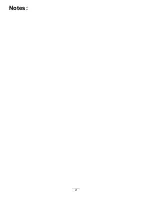
Figure 20
1.
Bedknife Lip Height *
6.
To adjust the height of cut when fixed plate kits are
installed on the cutting units, proceed as follows:
•
Remove the height of cut brackets and front roller
as described in Procedure 6 in the Set-Up section.
•
Install the cutting unit onto the traction unit as
described in the Traction Unit Operator's Manual.
•
Lower the cutting unit to the floor and measure the
distance from the floor to the top of the bedknife,
as shown in Figure 21
g017024
Figure 21
1.
Fixed plate
3.
Rear height of cut spacers
2.
Upper mounting holes
4.
Height of cut
•
To attain the desired height of cut, adjust the rear
roller brackets to the desired height of cut range by
positioning the required amount of spacers below
the side plate mounting flange per the HOC Chart.
Refer to Adjusting the Rear Roller.
Note:
To achieve a
less
aggressive cut, mount
the cutting unit links in the number 1 position or
mount the links to the number 3 position for a
more
aggressive cut.
Cutting Unit Characteristics
The dual knob bedknife-to-reel adjustment system
incorporated in this cutting unit simplifies the adjustment
procedure needed to deliver optimum mowing performance.
The precise adjustment possible with the dual knob/bedbar
design gives the necessary control to provide a continual
self-sharpening action-thus maintaining sharp cutting edges,
ensuring good quality-of-cut, and greatly reducing the need
for routine back lapping.
Daily Adjustments of Cutting Unit
Prior to mowing each day, or as required, each cutting unit
must be checked to verify proper bedknife-to-reel contact.
This must be performed even though quality of cut is
acceptable.
1.
Lower the cutting units onto a hard surface, shut off
the engine, and remove the ignition key.
2.
Slowly rotate the reel in a reverse direction, listening
for reel-to-bedknife contact. If no contact is evident,
turn the bedknife adjusting knobs clockwise, one click
at a time, until light contact is felt and heard.
Note:
The reel must cut one sheet of paper, when
inserted at a right angle to the bedknife, at both ends
and the center of the reel.
Note:
The adjustment knobs have detents
corresponding to 0.022 mm (0.0009 inch) bedknife
movement for each indexed position.
3.
If excessive contact/reel drag is evident it will be either
necessary to backlap, reface the front of the bedknife,
or regrind the cutting unit to achieve the sharp edges
needed for precision cutting (Refer to the Toro Manual
for Sharpening Reel and Rotary Mowers, Form No.
09168SL).
Important:
Light contact is preferred at all times.
If light contact is not maintained, the bedknife/reel
edges will not sufficiently self-sharpen and dull
cutting edges will result after a period of operation.
If excessive contact is maintained, bedknife/reel
wear will be accelerated, uneven wear can result,
and quality of cut may be adversely affected.
Note:
As the reel blades continue to run against the
bedknife, a slight burr will appear on the front cutting
edge surface along the full length of the bedknife. If a
file is occasionally run across the front edge to remove
this burr, improved cutting can be obtained.
After extended running, a ridge will eventually develop
at both ends of the bedknife. These notches must be
rounded off or filed flush with the cutting edge of the
bedknife to ensure smooth operation.
Note:
Over time, the chamfer (Figure 22) will need to
be reground as it is only designed to last 40% of the
bedknife life.
13










































